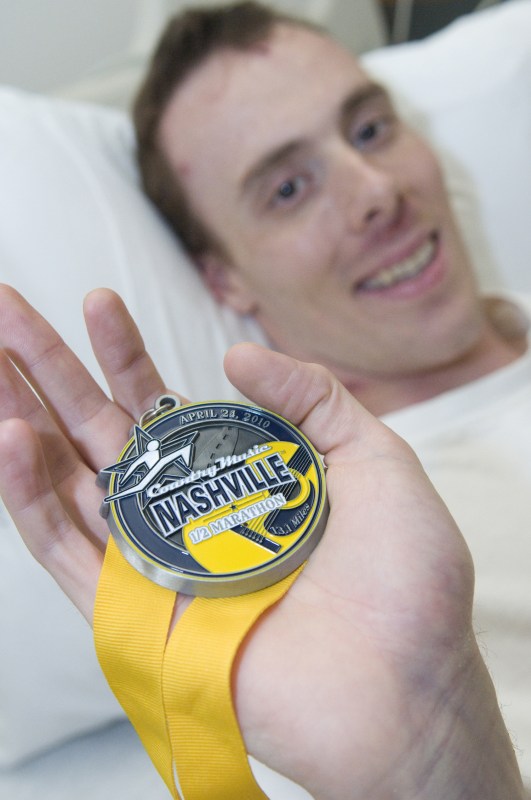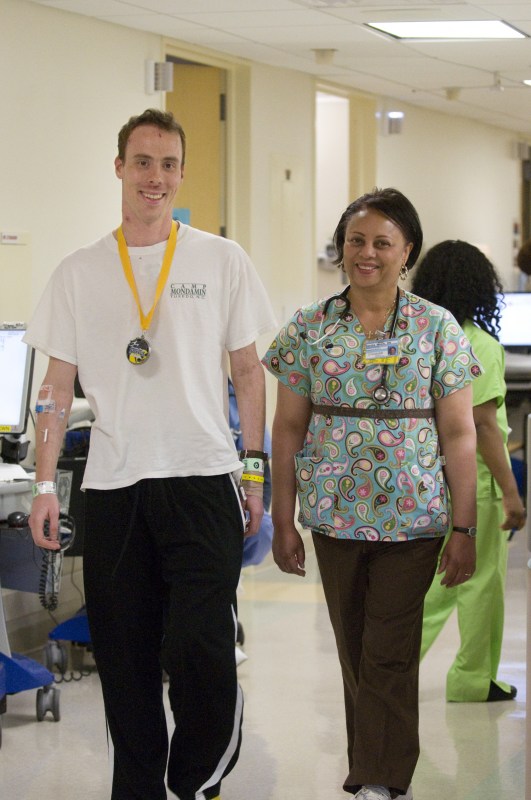
Heart patient Whit Wilson shows off his medal for running in the half marathon. (photo by Mary Donaldson)
‘Cool treatment’ aids stricken runner
For 32-year-old Whit Wilson of Atlanta, the Country Music Half Marathon on April 24 was to be a reunion with his high school running buddies.
An avid runner since his days on his high school cross country team, Wilson took his place at the starting line early that stormy Saturday morning.
He ran with a friend for the first 10 miles, but when his friend slowed down, Wilson, who had never run a half marathon before, maintained his pace and finished the last three miles on his own.
“It was rough racing conditions with high humidity that slowed my pace,” Wilson recalled. “I had run 10 miles in the past at faster paces with no problems.”
As he completed the 13.1 miles and crossed the finish line, he went into cardiac arrest and collapsed.
EMTs on the scene immediately began CPR and took Wilson to Nashville General Hospital at Meharry, where physicians restored a normal heart rate, sedated and intubated him, and transferred him to Vanderbilt Heart & Vascular Institute.
Upon his arrival, Mark Robbins, M.D., assistant professor of Medicine, initiated the therapeutic hypothermia protocol because Wilson was at risk for anoxic brain injury due to prolonged lack of oxygen.
In the Cardiovascular Intensive Care Unit, Robbins oversaw the lowering of Wilson's body temperature to about 34 degrees Celsius (93.2 degrees Fahrenheit).
Covers containing circulating cold water were placed over Wilson's body and around his head.
A machine slowly and carefully lowered the body temperature and maintained it for 24 hours.
Therapeutic hypothermia has been shown to prevent cell death and injury when instituted and properly timed, thereby slowing and reversing brain injury during the first 24 hours after cardiac arrest, Robbins said.
Returning Wilson to normal body temperature was also a very slow, controlled process that occurred at 1 degree Celsius every hour.
“In clinical trials, therapeutic hypothermia works best for those who have a witnessed cardiac event and can be resuscitated in the 5- to 15-minute window,” Robbins said.
After his body temperature was returned to normal, Wilson regained consciousness and his neurologic status improved daily.
Robbins ran a battery of tests on Wilson to figure out what happened and why he arrested at such a young age. All test results were normal.
“He had only been running about three miles per day prior to the half marathon. In talking with him, it appears he pushed himself very hard to run it. He collapsed due to dehydration and electrolyte shifts, which led to cardiac irritability and his arrest.

Whit Wilson, who suffered a heart attack after completing the Country Music Half Marathon, exercises in the Cardiac Unit with Sandra Welch, R.N. (photo by Mary Donaldson)
“The incidence of sudden death has been reported to be one in 50,000 marathon runners. In the Country Music Marathon and Half Marathon, there were 30,000 to 40,000 people running and there were multiple runners who collapsed from dehydration. Whit's case was significantly more serious and could have resulted in death if on-site resuscitation was not performed.
“Although the probability is low, sudden death is a reality in healthy people who push themselves physically beyond what their bodies can handle,” Robbins said.
Wilson was discharged from Vanderbilt University Hospital on May 1.
He is recovering nicely and hopes to return to his job as a health care marketing director in about a month.
“I am extremely grateful for the attentive and excellent care that I received while at Vanderbilt,” Wilson said. “The care that I received was highly personalized and made me feel like an individual rather than just another patient.
“I am glad to be on the path to successful recovery — this could have played out very differently.”













